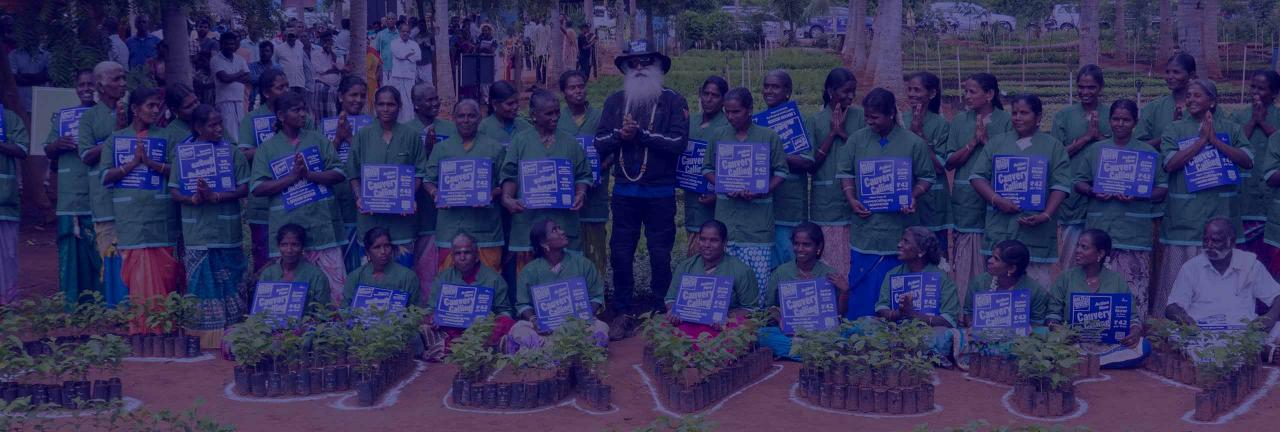- 109 million living trees planted
- 213,000 farmers shifted to tree-based agriculture
- UN Convention to Combat Desertification (UNCCD) accreditation
- Observer status to the United Nations Environment Assembly (UNEA) of UNEP
- Rs. 19,000 crores (~2.5 billion USD) allocated by Govt. of India to revitalize 13 rivers in line with the Rally for Rivers draft policy recommendations
"Cauvery has been the source of wellbeing, prosperity and the very source of life for these lands. A forest-fed perennial river is fast becoming a seasonal stream as 87% of tree cover has been removed in 50 years. Cauvery is calling, do you have a heart to hear?" – Sadhguru
Cauvery Calling is a first of its kind campaign, setting the standard for how India’s rivers – the country’s lifelines – can be revitalized. It will initiate the revitalization of Cauvery river and transform the lives of 84 million people.
The story so far...
Cauvery Calling is a movement that germinated from a seed that was planted over two decades ago.
In 1998, a team of experts predicted that by 2025, nearly 60% of Tamil Nadu would become a desert. That this rich land, which has been farmed continuously for more than 12,000 years, could become a desert seemed inconceivable to Sadhguru, who, in his own words, does not like predictions. Sadhguru decided to drive around Tamil Nadu to assess the situation himself. He realized then that we might not even make it to 2025... Not only had small rivers dried up and homes been built on their riverbeds, there was not enough moisture in the soil for even palm trees – typical desert vegetation – to survive. It was evident that the rampant loss of tree cover was rapidly leaving the once-rich soil barren and turning the land into desert. It was at this point that the blueprint to bring back green cover and turn the tide for our soil and water was conceived.
The Beginning
The initial years were spent in creating a core group of people with a deep understanding and concern for the environment. The very first activity we engaged in was to green our own backyard. The glorious Velliangiri Hills, which form the backdrop of the Isha Yoga Center, had been stripped bare, brown from years of illegal timber trade. Under Sadhguru’s guidance, a few hundred volunteers joined forces. Over 22 days, using simple implements, they went up these hills and sowed close to six million seeds of native species. Today our Velliangiris are moist and green right through the torrid summer months. This momentum segued in 2002 into Vanashree Eco Center, a volunteer-driven tree planting initiative.
Planting Trees in People’s Minds
With desertification looming over the state, Sadhguru conceived and communicated the plan for Tamil Nadu to meet the national aspiration of 33% green cover. He estimated that close to 114 million trees would need to be planted across the state to achieve this goal. People around Sadhguru were flabbergasted: at the time, this felt like an impossibly ambitious task.
Sadhguru first set about “planting trees in people’s minds” – the most difficult of terrains! Leading people through experiential processes where they were able to perceive how intimately our lives and our life-breath are connected to trees, Sadhguru opened their hearts to the vital need for restoration.
The Formative Years
Project GreenHands (PGH) was launched in 2004 and, in many ways, it was the pilot and the proof-of-concept for the massive work that is underway today. PGH had many large-scale initiatives such as the Green School Movement and Trees for All to involve young, school-going children and the general public. It also had intensive programs to collaborate with farmers, including the Save Soil – Thaaimann Kaakkum Vivasaayam movement, based on the principles of organic farming, and Trees for Life, an initiative based on the tree-based agriculture model. For these phenomenal efforts, and a Guinness record for the largest single-day tree plantation drive, Isha received India’s highest environmental award, the Indira Gandhi Paryavaran Puraskar, in 2010.
The Big Bang
Heartening as these achievements were, they still lacked the scale required to reverse the disastrous course we had set for India’s rivers through our collective mismanagement. What was needed was drastic, wide-reaching awareness, a redirection of National Policy and urgent action on the ground. Sadhguru stepped forward to inspire this revolution. In 2017, leading the month-long “Rally for Rivers” through 16 Indian states governed by parties across the political spectrum, garnering the support of 162 million people, Sadhguru arrived in New Delhi and presented to the Prime Minister a 761-page report titled Revitalization of Rivers in India: Draft Policy Recommendation. This intensive and exhaustive document – prepared with inputs from various experts from diverse fields relating to forestry, soil, agriculture, governance, finance, corporate, education and development – was taken up for study and action with tremendous alacrity by the Central Government. Under the aegis of the NITI Aayog (a policy think tank of the Government of India, established to achieve Sustainable Development Goals), an inter-ministerial committee of government secretaries and experts evaluated the draft policy in detail, and then went on to issue a policy advisory to all 29 state governments about the principles and policies relating to river revitalization. Things started to look up when several state governments across the nation began to implement these recommendations.
More recently, the Ministry of Environment, Forest and Climate Change, Government of India, prepared Detailed Project Reports on rejuvenating 13 of the country’s rivers in line with the Rally for Rivers draft policy recommendations and allocated Rs. 19,000 crores towards these projects.
Cauvery is Calling
In the summer of 2019, the city of Chennai was hit by a water crisis of horrifying proportions. As with so many of India’s large riverine systems, Cauvery, the lifeline of southern India, was rapidly dying. This crisis, in conjunction with several allied issues such as poor soil health, cycles of flood and drought, the resultant farmer distress and migration, was creating a situation of growing despair. Immediate action was called for.
At Isha, we were already aware that a large-scale demonstration of the recommended model of eco-restoration was vital to its widespread adoption. Therefore, when this crisis presented itself, it was the cue to embark on our mammoth on-ground demonstration for river revitalization through the “tree-based agriculture” model. Cauvery Calling – the world’s largest farmer-driven eco-movement – was launched.
The ambition is to enable 5.2 million farmers to plant 2.42 billion trees in Cauvery basin in a span of 12 years. We are supporting the farmers in a multi-faceted way to adopt tree-based agriculture, and eventually bring one-third of the basin under tree cover. From the preparation of quality saplings to ensuring farmer interest, from farmer education to bringing about required government policy changes, from government incentives for farmers to partnering with like-minded NGOs – we are working at every conceivable level to scale up this movement. This has included working extensively with the Central Government and the concerned State Governments, leading tangibly to several policy reforms. These reforms cover a broad range of aspects affecting the farmer - from reforms in agricultural practices at one end to helping make Farmer Producer Organizations (FPOs) viable and giving them tax incentives at the other.
The most fantastic part of this journey has been that we have succeeded in bringing together all stakeholders from every section of society, including farmers, scientists, civil society groups, state governments, the citizens and the media, and inspiring them to focus their energies on a common ecological goal. For the farmer, it is a highly lucrative economic model with significant ecological benefits. For the state and citizens, it is a double win.
The impact we have already seen in the pilot years in terms of soil quality, groundwater sequestration, improved farmer income and the benefits of increased green cover are all on road to being demonstrated exponentially with this massive on-ground movement. The vision is to establish a blueprint for tropical river restoration that can be replicated and implemented across the planet. The idea is to innovate, demonstrate, amplify and inspire planetary scale.
In this gargantuan endeavor, we hold an open door to anyone who wishes to work and support to make this happen. Individuals, governments, corporations, organizations, international entities – we seek, and welcome, and value your support. The true fruition of this project would be in humanity coming together to aid and amplify its success.























.svg)
.png)









